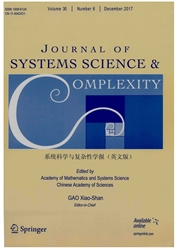

 中文摘要:
中文摘要:
微生物批式流加发酵生产1,3-丙二醇是一种重要的生产方式,但是目前研究只考虑了细胞外5种物质浓度的变化,没有考虑代谢机理、细胞内物质浓度的变化及重要的中间产物。本文将细胞内甘油、3-羟基丙醛和1,3-丙二醇三种物质的浓度变化考虑在内,假设甘油跨膜运输情形为主动运输和被动扩散,1,3-丙二醇的跨膜运输情形为主动运输和被动扩散,建立了微生物批式流加发酵动力系统。以实验值与计算值的误差平方和作为性能指标建立参数辨识模型,并用改进的粒子群算法求解模型中参数。结果表明,改进后模型平均相对误差比现有文献略有降低,说明了模型的有效性。
 英文摘要:
英文摘要:
The method of microbial fermentation is an important mode of production in producing 1,3-Propanediol(1,3-PD). Although the microbial fed-batch culture of glycerol to 1,3-PD is a vital production mode, the present research results of microbial fed-batch culture system which only think about the concentration of five kinds extracellular materials changed instead of metabolic mechanism, concentration of intracellular materials changed and important intermediate products. We take the concentration of intracellular glycerol, 3-HPA and 1,3-PD into consideration in this paper. A dynamic system of microbial fed-batch fermentation is built under the active transport and passive diffusion of glycerol and active transport and passive diffusion of 1,3-PD. Taking the sum of square error between experimental data and computational values as the performance index, the parameter identification model is presented and an improved particle swarm optimization algorithm is developed to seek the unknown parameters in the model. Numerical simulations show that the average relative errors of biomass and glycerol have reduced slightly and illustrate the availability in the improved model.
 同期刊论文项目
同期刊论文项目
 同项目期刊论文
同项目期刊论文
 Complex metabolic network of glycerol fermentation by Klebsiella pneumoniae and its system identific
Complex metabolic network of glycerol fermentation by Klebsiella pneumoniae and its system identific Robust analysis of hybrid dynamical systems for 1, 3-propanediol transport mechanisms in microbial c
Robust analysis of hybrid dynamical systems for 1, 3-propanediol transport mechanisms in microbial c Pathway identification using parallel optimization for a complex metabolic system in microbial conti
Pathway identification using parallel optimization for a complex metabolic system in microbial conti Modeling and identification of a nonlinear hybrid dynamical system in batch fermentation of glycerol
Modeling and identification of a nonlinear hybrid dynamical system in batch fermentation of glycerol Parameter identification and application of a distributed parameter coupled system with a movable in
Parameter identification and application of a distributed parameter coupled system with a movable in Modelling and well-posedness of a nonlinear hybrid system in fed-batch production of 1,3-propanediol
Modelling and well-posedness of a nonlinear hybrid system in fed-batch production of 1,3-propanediol Stability of nonlinear microbial bioconversion system concerning glycerol';s active transport and 1,
Stability of nonlinear microbial bioconversion system concerning glycerol';s active transport and 1, Automatic Control Design for Optimal Strategy in Fed-batch Culture with Coupled Feed of Glycerol and
Automatic Control Design for Optimal Strategy in Fed-batch Culture with Coupled Feed of Glycerol and Infer objective function of glycerol metabolism in klebsiella pneumoniae basing on bilevel programmi
Infer objective function of glycerol metabolism in klebsiella pneumoniae basing on bilevel programmi Properties and optimality conditions of a three-dimension non-smooth thermodynamic system of sea ice
Properties and optimality conditions of a three-dimension non-smooth thermodynamic system of sea ice Stability and boundedness criteria for nonlinear differential systems relative to initial time diffe
Stability and boundedness criteria for nonlinear differential systems relative to initial time diffe An improved model for multistage simulation of glycerol fermentation in batch culture and its parame
An improved model for multistage simulation of glycerol fermentation in batch culture and its parame MODELLING AND OPTIMAL CONTROL FOR NONLINEAR MULTISTAGE DYNAMICAL SYSTEM OF MICROBIAL FED-BATCH CULTU
MODELLING AND OPTIMAL CONTROL FOR NONLINEAR MULTISTAGE DYNAMICAL SYSTEM OF MICROBIAL FED-BATCH CULTU Single-machine scheduling with a sum-of-processing-time based learning effect and deteriorating jobs
Single-machine scheduling with a sum-of-processing-time based learning effect and deteriorating jobs Optimal control and properties of nonlinear multistage dynamical system for planning horizontal well
Optimal control and properties of nonlinear multistage dynamical system for planning horizontal well 期刊信息
期刊信息
